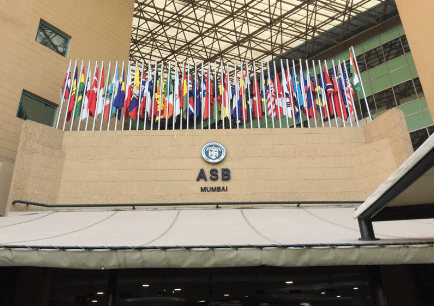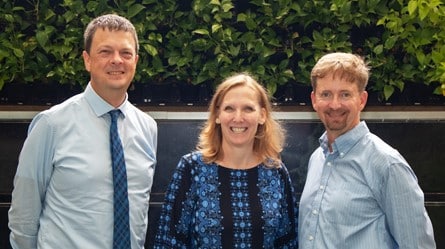

In early 2018 I presented my first Responsive Classroom course at the American School of Bombay (ASB) in Mumbai, India. This independent day school follows a college preparatory curriculum that supports an American Diploma or an International Baccalaureate (IB) Diploma for grades K-12.
During that time I met Casey Faulknall, middle school principal at the American School of Bombay. Getting to know Casey and working with her teachers was gratifying. We engaged in several conversations around Responsive Classroom and how Center for Responsive Schools’s mission and beliefs around academics and social-emotional learning align with ASB’s values and mission. I would return to ASB a year later to present the Responsive Classroom Middle School Course to a new group of educators and to help the school continue implementation of the Responsive Classroom approach.
In January 2020, I attended the European League for Middle-Level Education conference in Budapest, Hungary. While I knew I would see some familiar faces, I did not expect to see Casey and we had an opportunity to reconnect. ASB had recently become the first school to receive the designation of International School to Watch, a program under the National Forum to Accelerate Middle Grades Reform. The International Schools to Watch program seeks to identify and honor diverse, high-performing, model middle-level schools.
Responsive Classroom Professional Development Designer and Consulting Teacher Michelle Benson sat down with Casey Faulknall to learn about the American School of Bombay’s journey with social and emotional learning, their adoption of the Responsive Classroom approach, and how those things led them to their being designated an International School to Watch.
Benson: Your school mission says, “We inspire all of our students to continuous inquiry, empowering them with the skills, courage, optimism, and integrity to pursue their dreams and enhance the lives of others.” How do you see this mission in action regularly, both with students and staff? What academic and social-emotional learning competencies do you focus on developing with middle school students to help reach your mission?
Faulknall: We are proud of our advisory program, which supports the development of each child’s ethical, intellectual, and social growth. As part of the program, we adhere to the Responsive Classroom model and utilize its strategies and structures. Each child is part of an advisory group of 14 to 16 students, which is subdivided further into mentor groups of 7 to 8 students. Each child meets with their own mentor on Mentor Monday in smaller groups or individually to discuss social issues, to examine academic progress, or to talk about who they are and how they can grow as people and learners. Students set their own goals and discuss them throughout the year with their mentors. At the start of the second semester, mentors meet with students and parents to share mid-year progress on student goals. In the spring, students share the outcome of their goals at Student-Led Conferences (SLC’s). At SLC’s, students also share who they are as learners, how they are exploring their dreams, and what connections they have made to our school mission.
Advisory allows us to mentor, advocate for, and advise our students and helps us personalize their learning experience.
Benson: Working with your staff, I see the commitment to excellence each brings to the position and the positive impact it has on students. At this point the majority, if not all, of your staff have completed the Responsive Classroom Middle School Course. What are some positive effects you have seen on your teachers since they have participated in the training?
Faulknall: There are many positive benefits to having our teachers trained in the methods of Responsive Classroom. The most important piece we have seen is around culture. It has created a feeling of shared ownership of the program and our teachers being able to utilize their peers for support and guidance. At ASB, we believe wholeheartedly in having teachers participate in peer coaching, and by having all of our teachers trained in Responsive Classroom they are able to focus on coaching each other to support their classrooms. It has also allowed us to have a common language within our middle school to further support the systems and structures within our school.
Benson: Schools to Watch are recognized for their best practices and continued journey towards excellence. What do you see as your primary focus going forward that supports this path?
Faulknall: Putting middle school students at the center of their educational path and furthering student agency is a primary goal for us and aligns with the strategic vision of ASB. With this in mind, we look for ways to support our students and to create educational experiences that meet their social and academic needs. This means that students, parents, and teachers are involved with creating relevant and meaningful educational pathways for our middle school students. At ASB, we are continually looking at ways to enhance the experience for our students by offering them personalized pathways to achieve their educational goals.
One of our innovative programs, entitled Studio 6, is a week where students get to explore passions and interests in a wide variety of fields.
ASB is also involved in a professional network with other innovative international and independent U.S. schools (Frankfurt International School, Cary Academy, Nueva, Singapore American School, and American International School of Johannesburg) around the world. The focus of the Collaborative for Innovative Education (CIE) is to share resources and ideas while considering the future changing role of education. It has three guiding principles: relevance, personalization, and connections. Being a part of this professional learning community allows for our middle school faculty to learn with and from other educators at other schools in order to reflect on our current practices and consider future initiatives.
Benson: Describe how using the Responsive Classroom approach has directly affected the lives of the students at ASB. What were some indicators for you that this approach was working?
Faulknall: Responsive Classroom techniques have helped empower our teachers to work with their students in creating positive and productive classroom environments. By creating a common vocabulary across the school, Responsive Classroom techniques have become the default when adults interact with students and the result has been that our students have developed a common vocabulary around how to perform best in the classroom. There have been fewer referrals to the office for behavior incidents this year, indicating that teachers and students have learned how to navigate conflict constructively in their own classrooms. Moreover, anecdotal evidence from teachers has indicated that judicious use of brain breaks and interactive learning structures have helped more students focus better and for longer periods of time. Beyond improved behavior, we have also seen effective use of Interactive Modeling in our classes, advisories, and assemblies.